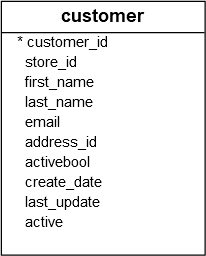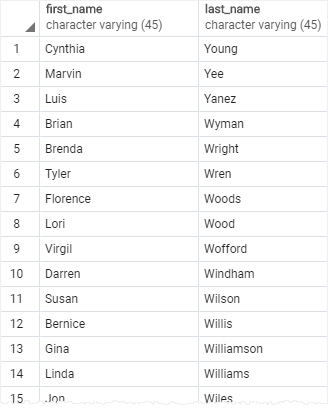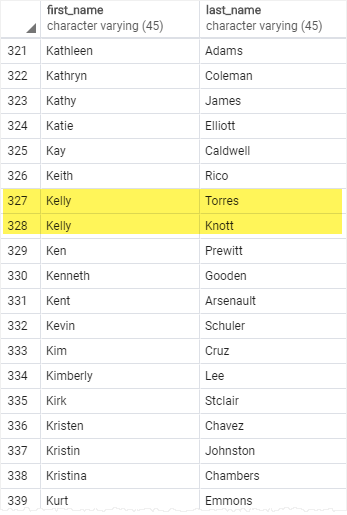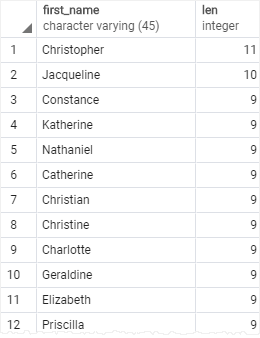Summary
: in this tutorial, you will learn how to use the PostgreSQL
ORDER BY
clause to sort the rows of a query by one or more criteria.
Create a free Postgres Database in 0.3 seconds on
Sponsored
Introduction to PostgreSQL ORDER BY clause
When you query data from a table, the
SELECT
statement returns rows in an unspecified order. To sort the rows of the result set, you use the
ORDER BY
clause in the
SELECT
statement.
The
ORDER BY
clause allows you to sort rows returned by a
SELECT
clause in ascending or descending order based on a sort expression.
The following illustrates the syntax of the
ORDER BY
clause:
SELECT
select_list
table_name
ORDER BY
sort_expression1 [ASC | DESC],
sort_expression2 [ASC | DESC],
...;Code language: SQL (Structured Query Language) (sql)In this syntax:
-
First, specify a sort expression, which can be a column or an expression, that you want to sort after the
ORDER BYkeywords. If you want to sort the result set based on multiple columns or expressions, you need to place a comma (,) between two columns or expressions to separate them. -
Second, you use the
ASCoption to sort rows in ascending order and theDESCoption to sort rows in descending order. If you omit theASCorDESCoption, theORDER BYusesASCby default.
PostgreSQL evaluates the clauses in the
SELECT
statement in the following order:
FROM
,
SELECT
, and
ORDER BY
:

Due to the order of evaluation, if you have a column alias in the
SELECT
clause, you can use it in the
ORDER BY
clause.
Let’s take some examples of using the PostgreSQL
ORDER BY
clause.
PostgreSQL ORDER BY examples
We will use the
customer
table in the
sample database
for the demonstration.

1) Using PostgreSQL ORDER BY clause to sort rows by one column
The following query uses the
ORDER BY
clause to sort customers by their first names in ascending order:
SELECT
first_name,
last_name
customer
ORDER BY
first_name ASC;Code language: SQL (Structured Query Language) (sql)
Since the
ASC
option is the default, you can omit it in the
ORDER BY
clause like this:
SELECT
first_name,
last_name
customer
ORDER BY
first_name;Code language: SQL (Structured Query Language) (sql)2) Using PostgreSQL ORDER BY clause to sort rows by one column in descending order
The following statement selects the first name and last name from the
customer
table and sorts the rows by values in the last name column in descending order:
SELECT
first_name,
last_name
customer
ORDER BY
last_name DESC;Code language: SQL (Structured Query Language) (sql)
3) Using PostgreSQL ORDER BY clause to sort rows by multiple columns
The following statement selects the first name and last name from the customer table and sorts the rows by the first name in ascending order and last name in descending order:
SELECT
first_name,
last_name
customer
ORDER BY
first_name ASC,
last_name DESC;Code language: SQL (Structured Query Language) (sql)
In this example, the ORDER BY clause sorts rows by values in the first name column first. Then it sorts the sorted rows by values in the last name column.
As you can see clearly from the output, two customers with the same first name
Kelly
have the last name sorted in descending order.
4) Using PostgreSQL ORDER BY clause to sort rows by expressions
The
LENGTH()
function accepts a string and returns the length of that string.
The following statement selects the first names and their lengths. It sorts the rows by the lengths of the first names:
SELECT
first_name,
LENGTH(first_name) len
customer
ORDER BY
len DESC;Code language: SQL (Structured Query Language) (sql)
Because the
ORDER BY
clause is evaluated after the
SELECT
clause, the column alias
len
is available and can be used in the
ORDER BY
clause.
PostgreSQL ORDER BY clause and NULL
In the database world,
NULL
is a marker that indicates the missing data or the data is unknown at the time of recording.
When you sort rows that contain
NULL
, you can specify the order of
NULL
with other non-null values by using the
NULLS FIRST
or
NULLS LAST
option of the
ORDER BY
clause:
ORDER BY sort_expresssion [ASC | DESC] [NULLS FIRST | NULLS LAST]Code language: CSS (css)
The
NULLS FIRST
option places
NULL
before other non-null values and the
NULL LAST
option places
NULL
after other non-null values.
Let’s create a table for the demonstration.
-- create a new table
CREATE TABLE sort_demo(num INT);
-- insert some data
INSERT INTO sort_demo(num)
VALUES
(1),
(2),
(3),
(null);Code language: SQL (Structured Query Language) (sql)
Note that if you are not yet familiar with the
CREATE TABLE
and
INSERT
statements, you can simply execute them from
pgAdmin
or
psql
to create the
sort_demo
table and insert data into it.
The following query returns data from the
sort_demo
table:
SELECT
sort_demo
ORDER BY
num;Code language: SQL (Structured Query Language) (sql)Output:
num
------
(4 rows)Code language: JavaScript (javascript)
In this example, the
ORDER BY
clause sorts values in the
num
column of the
sort_demo
table in ascending order. It places
NULL
after other values.
Note that psql displays null as an empty string by default. To make null clearer, you can execute the following command to change an empty string to another such as null:
\pset null nullCode language: JavaScript (javascript)Output:
Null display is "null".Code language: PHP (php)
So if you use the
ASC
option, the
ORDER BY
clause uses the
NULLS LAST
option by default. Therefore, the following query returns the same result:
SELECT
sort_demo
ORDER BY
num NULLS LAST;Code language: SQL (Structured Query Language) (sql)Output:
num
------
(4 rows)Code language: JavaScript (javascript)
To place
NULL
before other non-null values, you use the
NULLS FIRST
option:
SELECT
sort_demo
ORDER BY
num NULLS FIRST;Code language: SQL (Structured Query Language) (sql)Output:
num
------
(4 rows)Code language: JavaScript (javascript)
The following statement sorts values in the
num
column of the
sort_demo
table in descending order:
SELECT
sort_demo
ORDER BY
num DESC;Code language: SQL (Structured Query Language) (sql)Output:
num
------
(4 rows)Code language: JavaScript (javascript)
The output indicates that the
ORDER BY
clause with the
DESC
option uses the
NULLS FIRST
by default.
To reverse the order, you can use the
NULLS LAST
option:
SELECT
sort_demo
ORDER BY
num DESC NULLS LAST;Code language: SQL (Structured Query Language) (sql)Output:
num